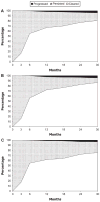Rapid clearance of human papillomavirus and implications for clinical focus on persistent infections
- PMID: 18364507
- PMCID: PMC3705579
- DOI: 10.1093/jnci/djn044
Rapid clearance of human papillomavirus and implications for clinical focus on persistent infections
Abstract
Health professionals and the public need to understand the natural history of human papillomavirus (HPV) infections of the cervix to best use the information provided by new molecular screening tests. We investigated outcomes of 800 carcinogenic HPV infections detected in 599 women at enrollment into a population-based cohort (Guanacaste, Costa Rica). For individual infections, we calculated cumulative proportions of three outcomes (viral clearance, persistence without cervical intraepithelial neoplasia grade 2 or worse [CIN2+], or persistence with new diagnosis of CIN2+) at successive 6-month time points for the first 30 months of follow-up. Cervical specimens were tested for carcinogenic HPV genotypes using an L1 degenerate-primer polymerase chain reaction method. Infections typically cleared rapidly, with 67% (95% confidence interval [CI] = 63% to 70%) clearing by 12 months. However, among infections that persisted at least 12 months, the risk of CIN2+ diagnosis by 30 months was 21% (95% CI = 15% to 28%). The risk of CIN2+ diagnosis was highest among women younger than 30 years with HPV-16 infections that persisted for at least 12 months (53%; 95% CI = 29% to 76%). These findings suggest that the medical community should emphasize persistence of cervical HPV infection, not single-time detection of HPV, in management strategies and health messages.
Figures


References
-
- Goldsmith MR, Bankhead CR, Kehoe ST, Marsh G, Austoker J. Information and cervical screening: a qualitative study of women’s awareness, understanding and information needs about HPV. J Med Screen. 2007;14(1):29–33. - PubMed
-
- Jain N, Irwin K, Carlin L, Freeman C, Montano D, Kasprzyk D. Use of DNA tests for human papillomavirus infection by US clinicians, 2004. J Infect Dis. 2007;196(1):76–81. - PubMed
-
- Tiro JA, Meissner HI, Kobrin S, Chollette V. What do women in the U.S. know about human papillomavirus and cervical cancer? Cancer Epidemiol Biomarkers Prev. 2007;16(2):288–294. - PubMed
-
- Brown D. Millions in U.S. infected with HPV. Washington Post. 2007 Feb 28;:A.1.
Publication types
MeSH terms
Substances
Grants and funding
LinkOut - more resources
Full Text Sources
Other Literature Sources
Medical

